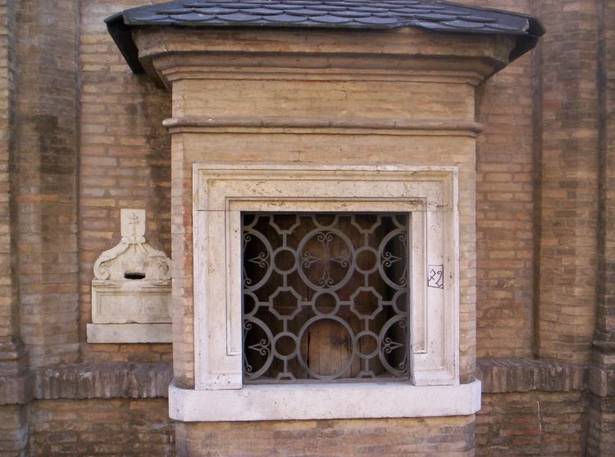


For the Roman Catholic Church in the Middle Ages, the fate of children born out of adultery was a problem. A Milanese high priest named Dateo therefore wrote in his last will and testament of February 787 that, “Not wanting the affair to be know, women who conceive as the consequence of adultery kill their own newborn infants, and in this way send the infants to hell without baptism. This happens because they [the women] cannot find a place to take them where they would be kept alive…so then they throw them into the sewers, the rubbish and river. Therefore I, Dateo, dispose the institution of an orphanage for babies in my house, and I intend for this orphanage to be placed legally under the power of Saint Ambrose.”
This was Italy’s first orphanage, but it did not quite go far enough. In the year 1198 Pope Innocent III had a recurring nightmare of seeing new-born babies being fished out of the Tiber River—as he may well have seen in daytime. So distressing was this vision that the pontiff ordered the Santo Spirito hospital to install a wooden “Ruota” (Wheel) behind a wooden door into which women could anonymously slip new-born babies they were unable to keep, then ring a bell before they fled into the night.
The hospital still exists near St. Peter’s Basilica on the banks of the Tiber, and is still at the service of Romans, pilgrims and tourists. And so is the problem of unwanted babies, along with the Ruota. Although it was gradually abolished all over Italy during the 19th C., in recent years the Ruota has had a come-back as a heated cradle which is kept under constant surveillance (the cradle, not the mother) by a TV camera.
Why should this be necessary in this day and age? Every year some 3,000 babies are abandoned in Italy. Three-quarters are children of Italian mothers, but the number being born to immigrant women is rapidly rising, to the point that women in Italy abandon eight babies every day of the year.
Many such women are in denial, authorities here explain. Some are very young schoolgirls or immigrant older women who fear family, social or religious reactions. Others are terrified of the reactions of husband or partner who suspects an adulterous relationship. And some of the very poorest fear losing the job that supports the children they have already, and so many of these hide their pregnancies until the last moment. A few are prostitutes. Over half of the cases involved a single parent with other children and 22%, single individuals.
Just as in the priest Dateo’s time, some of the newborns are dropped into dumpsters that will carry the baby into a rubbish tip where the child will be crushed. “We had three sad cases in 2006. Two babies were tossed into dumpsters and another left on the back ledge of a truck. All three were found and saved, but this told us that we had to take action,” Dr. Michele Paolillo, who heads the neonatal section of the Casilino Polyclinic of Rome [2], told a radio audience recently. “Another woman appeared with a newborn she said she had found on the street—but then she fainted, and we discovered that she was the mother. So we installed the heated cradle, and two months later had our first guest, who was rapidly adopted.”
The social makeup of Dr. Paolillo’s Roman neighborhood is a mixture of very poor Italian families and new immigrants. As a result, of the 2,000 births in his hospital over the past year, 37% were born to non-Italian women.
The present legislation needs retouching, he says, but in many ways is nevertheless “very avant-garde since a woman can give birth in a hospital and then, without risking penal action, can decide to relinquish the baby if she believes that in doing so she can give it a better life.”
Why was the Ruota phased out during the 19th C.? Because as more babies survived in the families and the population expanded, more babies were abandoned to public services, with over 4,000 a year in Milan alone, or almost one of every three births (30%). The cost to the public and charities was seen as too high.
The current revival of the Ruota began because of pressure from the right-to-life movement, whose supporters hoped that this would reduce the request for abortions, legal at public expense since May 1978. But social changes have outstripped the original ideological motivation, and for the past fourteen years Milan has been offering similar services free to the public. “We have a hot line that gives information of what’s available,” said Matilde Guarnieri of the Milan Region. “We think it’s our duty to ensure that both mother and child are safe so we also offer some support, including psychological, during the pregnancy.”
At Abbiategrasso on Christmas Eve last year one such heated cradle was inaugurated by Mons. Masperi. Outside are instructions in five languages: Italian, Spanish, Albanian, Russian and Arabic. At the touch of a button the door opens to the cradle and remains open exactly one minute. If a baby is placed within, the Blue Cross operator plus three volunteers from the Centro Aiuto alla Vita (CAV) are automatically contacted.
“We chose a place where there isn’t much light outside so that he mother won’t be frightened of being recognized, but is easy for an ambulance to reach,” one of the volunteers told a local reporter.
The cradle was a gift from a local engineer, Signor Bernardi and his wife, following an incident where, hearing whimpering, a girl came down into the street and—thinking to find an injured cat—found a newborn. That baby lived—and so will others, thanks to what a local reporter called “the cradle of love.”
Source URL: http://test.casaitaliananyu.org/magazine/focus/op-eds/article/cradle-love
Links
[1] http://test.casaitaliananyu.org/files/14672ospedalesantospiritoruota1276878633jpeg
[2] http://www.policlinicocasilino.it